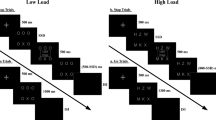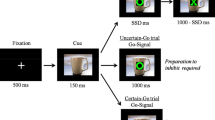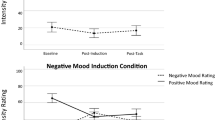Abstract
The ability to inhibit unwanted responses is critical for effective control of behavior, and inhibition failures can have disastrous consequences in real-world situations. Here, we examined how prior exposure to negative emotional stimuli affects the response-stopping network. Participants performed the stop-signal task, which relies on inhibitory control processes, after they viewed blocks of either negatively emotional or neutral images. In Experiment 1, we found that neural activity was reduced following negative image viewing. When participants were required to inhibit responding after neutral image viewing, we observed activation consistent with previous studies using the stop-signal task. However, when participants were required to inhibit responding after negative image viewing, we observed reductions in the activation of ventrolateral prefrontal cortex, dorsolateral prefrontal cortex, medial frontal cortex, and parietal cortex. Furthermore, analysis of neural connectivity during stop-signal task blocks indicated that across participants, emotion-induced changes in behavioral performance were associated with changes in functional connectivity, such that greater behavioral impairment after negative image viewing was associated with greater weakening of connectivity. In Experiment 2, we collected behavioral data from a larger sample of participants and found that stopping performance was impaired after negative image viewing, as seen in longer stop-signal reaction times. The present results demonstrate that negative emotional events can prospectively disrupt the neural network supporting response inhibition.






Similar content being viewed by others
Explore related subjects
Discover the latest articles and news from researchers in related subjects, suggested using machine learning.References
Anderson AK (2005) Affective influences on the attentional dynamics supporting awareness. J Exp Psychol Gen 134:258–281
Andersson JLR, Jenkinson M, Smith SM (2007a) Non-linear optimisation. FMRIB technical report TR07JA1. FMRIB Centre, Oxford
Andersson JLR, Jenkinson M, Smith SM (2007b) Non-linear registration aka spatial normalisation. FMRIB technical report TR07JA2. FMRIB Centre, Oxford
Aron AR, Fletcher PC, Bullmore ET, Sahakian BJ, Robbins TW (2003) Stop-signal inhibition disrupted by damage to right inferior frontal gyrus in humans. Nat Neurosci 6:115–116
Aron AR, Robbins TW, Poldrack RA (2004) Inhibition and the right inferior frontal cortex. Trends Cognit Sci 8:170–177
Aron AR, Robbins TW, Poldrack RA (2014) Inhibition and the right inferior frontal cortex: one decade on. Trends Cognit Sci 18:177–185
Band GPH, van der Molen MW, Logan GD (2003) Horse-race model simulations of the stop-signal procedure. Acta Psychol 112:105–142
Beckmann CF, Jenkinson M, Smith SM (2003) General multilevel linear modeling for group analysis in FMRI. Neuroimage 20:1052–1063
Berkman ET, Burklund L, Lieberman MD (2009) Inhibitory spillover: intentional motor inhibition produces incidental limbic inhibition via right inferior frontal cortex. Neuroimage 47:705–712
Chamberlain SR, Hampshire A, Muller U, Rubia K, del Campo N, Craig K, Regenthal R, Suckling J, Roiser JP, Grant JE, Bullmore ET, Robbins TW, Sahakian BJ (2009) Atomoxetine modulates right inferior frontal activation during inhibitory control: a pharmacological functional magnetic resonance imaging study. Biol Psychiatry 65:550–555
Chambers CD, Bellgrove MA, Stokes MG, Henderson TR, Garavan H, Robertson IH, Morris AP, Mattingley JB (2006) Executive “brake failure” following deactivation of human frontal lobe. J Cognit Neurosci 18:444–455
Chambers CD, Garavan H, Bellgrove MA (2009) Insights into the neural basis of response inhibition from cognitive and clinical neuroscience. Neurosci Biobehav Rev 33:631–646
Chepenik LG, Cornew LA, Farah MJ (2007) The influence of sad mood on cognition. Emotion 7:802–811
Cohen JR, Berkman ET, Lieberman MD (2013) Intentional and incidental self-control in ventrolateral prefrontal cortex. In: Stuss DT, Knight RT (eds) Principles of frontal lobe function, 2nd edn. Oxford University Press, Oxford, pp 417–440
Dan-Glauser ES, Gross JJ (2011) The temporal dynamics of two response-focused forms of emotion regulation: experiential, expressive, and autonomic consequences. Psychophysiology 48:1309–1322
De Houwer J, Tibboel H (2010) Stop what you are not doing! Emotional pictures interfere with the task not to respond. Psychon Bull Rev 17:699–703
Friston KJ, Buechel C, Fink GR, Morris J, Rolls E, Dolan RJ (1997) Psychophysiological and modulatory interactions in neuroimaging. Neuroimage 6:218–229
Hartikainen KM, Siiskonen AR, Ogawa KH (2012) Threat interferes with response inhibition. NeuroReport 23:447–450
Jenkinson M, Smith S (2001) A global optimisation method for robust affine registration of brain images. Med Image Anal 5:143–156
Jenkinson M, Bannister P, Brady M, Smith S (2002) Improved optimization for the robust and accurate linear registration and motion correction of brain images. Neuroimage 17:825–841
Kalanthroff E, Cohen N, Henik A (2013) Stop feeling: inhibition of emotional interference following stop-signal trials. Front Hum Neurosci 7:1–7
Lane RD, Chua PML, Dolan RJ (1999) Common effects of emotional valence, arousal and attention on neural activation during visual processing of pictures. Neuropsychologia 37:989–997
Lang PJ, Bradley MM, Cuthbert BN (2008) International affective picture system (IAPS): affective ratings of pictures and instruction manual. Technical report A-8. University of Florida, Gainsville
Lenartowicz A, Verbruggen F, Logan GD, Poldrack RA (2011) Inhibition-related activation in the right inferior frontal gyrus in the absence of inhibitory cues. J Cognit Neurosci 23:3388–3399
Lindstrom BR, Bohlin G (2012) Threat-relevance impairs executive functions: negative impact on working memory and response inhibition. Emotion 12:384–393
Logan GD (1994) On the ability to inhibit thought and action: a users’ guide to the stop signal paradigm. In: Dagenbach D, Carr TH (eds) Inhibitory processes in attention, memory, and language. Academic Press, San Diego, pp 189–239
Logan GD, Cowan WB (1984) On the ability to inhibit thought and action: a theory of an act of control. Psychol Rev 91:295–327
McLaren DG, Ries ML, Xu G, Johnson SC (2012) A generalized form of context-dependent psychophysiological interactions (gPPI): a comparison to standard approaches. Neuroimage 61:1277–1286
Ochsner KN (2000) Are affective events richly recollected or simply familiar? The experience and process of recognizing feelings past. J Exp Psychol Gen 129:242–261
O’Reilly JX, Woolrich MW, Behrens TEJ, Smith SM, Johansen-Berg H (2012) Tools of the trade: psychophysiological interactions and functional connectivity. Soc Cognit Affect Neurosci 7:604–609
Pawliczek CM, Derntl B, Kellermann T, Kohn N, Gur RC, Habel U (2013) Inhibitory control and trait aggression: neural and behavioral insights using the emotional stop signal task. Neuroimage 79:264–274
Pessoa L (2009) How do emotion and motivation direct executive control? Trends Cognit Sci 13:160–166
Pessoa L, Padmala S, Kenzer A, Bauer A (2012) Interactions between cognition and emotion during response inhibition. Emotion 12:192–197
Rebetez MML, Rochat L, Billieux J, Gay P, Van der Linden M (2015) Do emotional stimuli interfere with two distinct components of inhibition? Cognit Emot 29:559–567
Sagaspe P, Schwartz S, Vuilleumier P (2011) Fear and stop: a role for the amygdala in motor inhibition by emotional signals. Neuroimage 55:1825–1835
Smallwood J, Fitzgerald A, Miles LK, Phillips LH (2009) Shifting moods, wandering minds: negative moods lead the mind to wander. Emotion 9:271–276
Smith SM (2002) Fast robust automated brain extraction. Hum Brain Mapp 17:143–155
Stockdale LA, Morrison RG, Kmiecik MJ, Garbarino J, Silton RL (2015) Emotionally anesthetized: media violence induces neural changes during emotional face processing. Soc Cognit Affect Neurosci 10:1373–1382
Tabibnia G, Monterosso JR, Baicy K, Aron AR, Poldrack RA, Chakrapani S, Lee B, London ED (2011) Different forms of self-control share a neurocognitive substrate. J Neurosci 31:4805–4810
Verbruggen F, De Houwer J (2007) Do emotional stimuli interfere with response inhibition? Evidence from the stop signal paradigm. Cognit Emot 21:391–403
Verbruggen F, Logan GD (2008a) Automatic and controlled response inhibition: associative learning in the go/no-go and stop-signal paradigms. J Exp Psychol Gen 137:649–672
Verbruggen F, Logan GD (2008b) Response inhibition in the stop-signal paradigm. Trends Cognit Sci 12:418–424
Vuilleumier P (2005) How brains beware: neural mechanisms of emotional attention. Trends Cognit Sci 9:585–594
Woolrich M (2008) Robust group analysis using outlier inference. Neuroimage 41:286–301
Woolrich MW, Ripley BD, Brady M, Smith SM (2001) Temporal autocorrelation in univariate linear modeling of FMRI data. Neuroimage 14:1370–1386
Woolrich MW, Behrens TEJ, Beckmann CF, Jenkinson M, Smith SM (2004) Multilevel linear modelling for FMRI group analysis using Bayesian inference. Neuroimage 21:1732–1747
Worsley KJ (2001) Statistical analysis of activation images. In: Jezzard P, Matthews PM, Smith SM (eds) Functional MRI: an introduction to methods. Oxford University Press, Oxford, pp 251–270
Yu JX, Hung DL, Tseng P, Tzeng OJL, Muggleton NG, Juan CH (2012) Sex differences in how erotic and painful stimuli impair inhibitory control. Cognition 124:251–255
Acknowledgments
This research was supported by a National Science Foundation graduate research fellowship to T. K. Patterson (DGE-0707424), start-up funds provided by the University of Oregon to E. T. Berkman, a James S. McDonnell Foundation grant to R. A. Poldrack, and a National Science Foundation grant to B. J. Knowlton (BCS-0848246). We thank Lauren Skellern, Darren Liu, Chloe Su, and Carolyn Prina for assistance with data collection and Katherine Misogas for assistance with data analysis. We also thank Jeanette Mumford for advising on the neuroimaging analyses.
Author information
Authors and Affiliations
Corresponding author
Ethics declarations
Conflict of interest
The authors declare that they have no conflict of interest.
Ethical approval
All procedures performed in studies involving human participants were in accordance with the ethical standards of the institutional and/or national research committee and with the 1964 Helsinki declaration and its later amendments or comparable ethical standards.
Informed consent
Informed consent was obtained from all individual participants included in the study.
Electronic supplementary material
Below is the link to the electronic supplementary material.
Rights and permissions
About this article
Cite this article
Patterson, T.K., Lenartowicz, A., Berkman, E.T. et al. Putting the brakes on the brakes: negative emotion disrupts cognitive control network functioning and alters subsequent stopping ability. Exp Brain Res 234, 3107–3118 (2016). https://doi.org/10.1007/s00221-016-4709-2
Received:
Accepted:
Published:
Issue Date:
DOI: https://doi.org/10.1007/s00221-016-4709-2
Keywords
Profiles
- Agatha Lenartowicz View author profile




